Artillery tactics have undergone a remarkable evolution, transitioning from traditional methods to sophisticated modern systems that integrate technology and strategic innovations. These tactics play a crucial role in shaping battle outcomes, influencing troop morale, and disrupting enemy movements, thereby enhancing the overall effectiveness of military operations. Key developments in artillery, particularly during major conflicts, have redefined its application on the battlefield, making it an indispensable element of modern warfare.
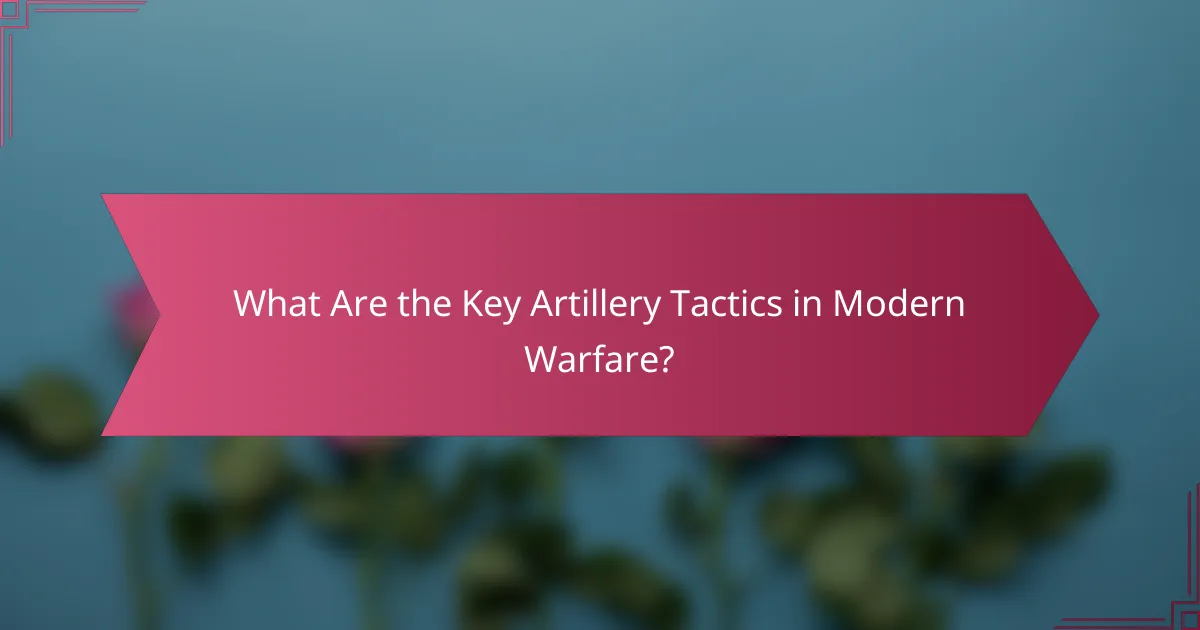
What Are the Key Artillery Tactics in Modern Warfare?
Key artillery tactics in modern warfare include indirect fire support, counter-battery fire, precision-guided munitions, mobile artillery units, and integrated fire support. These tactics enhance the effectiveness and efficiency of artillery units on the battlefield, adapting to the evolving nature of combat.
Indirect fire support
Indirect fire support involves targeting enemy positions from a distance without a direct line of sight. This tactic allows artillery units to strike targets hidden behind terrain or obstacles, providing crucial support to ground troops. Artillery shells can be fired at high angles, allowing for effective engagement of enemy forces while minimizing exposure to return fire.
Commonly used in modern conflicts, indirect fire support can include the use of howitzers and mortars. Artillery units often rely on forward observers to adjust fire and ensure accuracy, which is vital for minimizing collateral damage.
Counter-battery fire
Counter-battery fire is a tactic aimed at neutralizing enemy artillery before it can inflict damage. This involves detecting and targeting the source of enemy fire, often using radar systems or acoustic sensors to pinpoint artillery locations. Quick response is essential, as enemy artillery can cause significant casualties if left unchecked.
Effective counter-battery operations require coordination between reconnaissance units and artillery. Engaging enemy artillery with precision can significantly reduce the threat to friendly forces and improve overall battlefield control.
Precision-guided munitions
Precision-guided munitions (PGMs) enhance the accuracy of artillery strikes, allowing forces to hit specific targets with minimal collateral damage. These munitions utilize advanced guidance systems, such as GPS or laser guidance, to improve hit probability. This capability is particularly valuable in urban warfare, where civilian structures may be nearby.
PGMs can significantly reduce the number of rounds needed to achieve mission objectives, leading to more efficient use of resources. However, they often come at a higher cost compared to conventional munitions, necessitating careful consideration of their deployment.
Mobile artillery units
Mobile artillery units are designed for rapid deployment and repositioning on the battlefield. This mobility allows them to respond quickly to changing combat situations and avoid counter-battery fire. Self-propelled howitzers and truck-mounted artillery systems are examples of mobile units that enhance flexibility in operations.
Maintaining mobility is crucial for survival and effectiveness, as stationary artillery is more vulnerable to enemy attacks. Commanders must balance the need for mobility with the requirement for firepower, ensuring that artillery can support ground operations effectively.
Integrated fire support
Integrated fire support combines various firepower assets, including artillery, air support, and naval gunfire, to create a cohesive and effective attack strategy. This approach allows for coordinated strikes that leverage the strengths of different platforms, maximizing impact on enemy forces. Effective communication and planning are essential for successful integration.
By synchronizing artillery with other support elements, commanders can achieve a higher level of operational effectiveness. This tactic requires thorough training and coordination among different branches of the military to ensure seamless execution during combat operations.
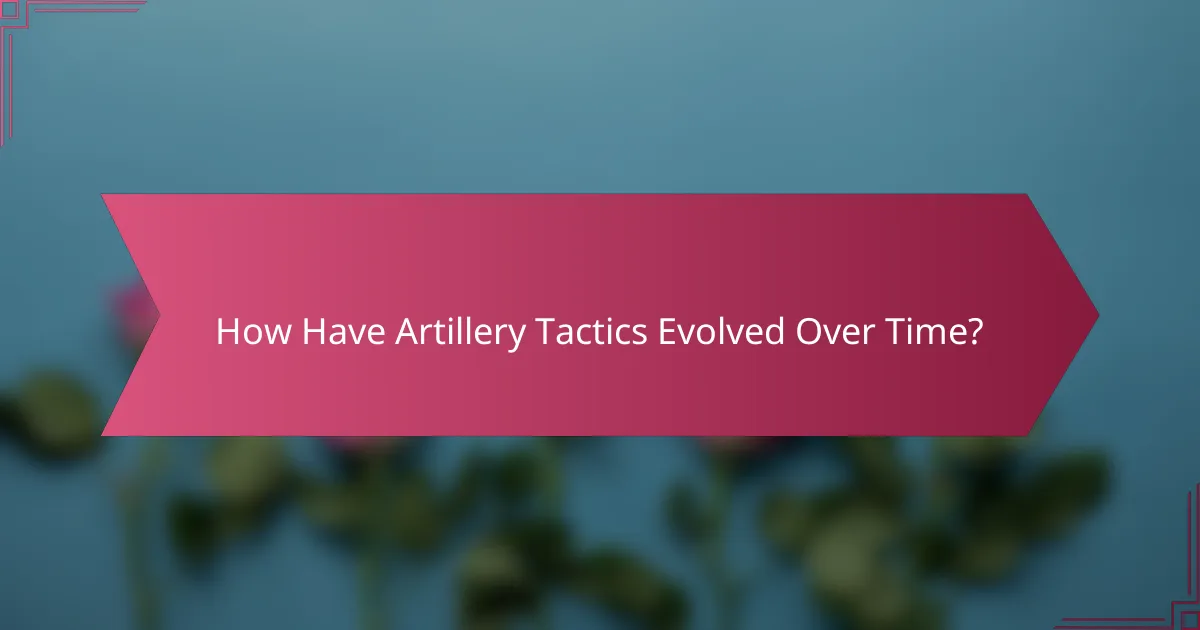
How Have Artillery Tactics Evolved Over Time?
Artillery tactics have evolved significantly from traditional methods to modern integrated systems, adapting to changes in technology and warfare strategies. Key developments include innovations during major conflicts that reshaped how artillery is used on the battlefield.
World War I innovations
World War I marked a turning point in artillery tactics with the introduction of indirect fire and the use of artillery in a more strategic role. Techniques such as counter-battery fire and the use of creeping barrages allowed for more effective targeting of enemy positions while minimizing exposure to direct fire.
The integration of railroads and motor vehicles facilitated the rapid deployment of artillery units, enabling them to support infantry movements more effectively. This period also saw the development of larger caliber guns, which increased the range and destructive power of artillery strikes.
World War II advancements
During World War II, artillery tactics advanced further with the introduction of self-propelled guns and improved targeting technology. The use of aerial reconnaissance and radar allowed for more precise targeting and quicker response times, enhancing the effectiveness of artillery support in combined arms operations.
Additionally, the concept of massed artillery fire became prominent, where large numbers of artillery pieces would concentrate fire on a specific target, overwhelming enemy defenses. This tactic was notably used during the D-Day invasion and in the Battle of Stalingrad.
Cold War developments
The Cold War era saw the rise of nuclear artillery and the development of advanced targeting systems, including computer-assisted fire control. Artillery units became more mobile and versatile, with the introduction of multiple launch rocket systems (MLRS) that could deliver a variety of munitions quickly and accurately.
Moreover, the emphasis on joint operations led to better coordination between artillery and other military branches, enhancing overall battlefield effectiveness. The integration of intelligence and surveillance systems improved the ability to gather real-time data for artillery targeting.
Modern technological integration
Today, artillery tactics are heavily influenced by modern technology, including precision-guided munitions and advanced communication systems. The ability to integrate artillery with drones and satellite imagery allows for real-time targeting and adjustments, significantly increasing accuracy and reducing collateral damage.
Furthermore, the use of automated systems and artificial intelligence is beginning to shape future artillery operations, enabling faster decision-making and more efficient resource allocation. As warfare continues to evolve, staying updated on these technological advancements is crucial for effective artillery tactics.
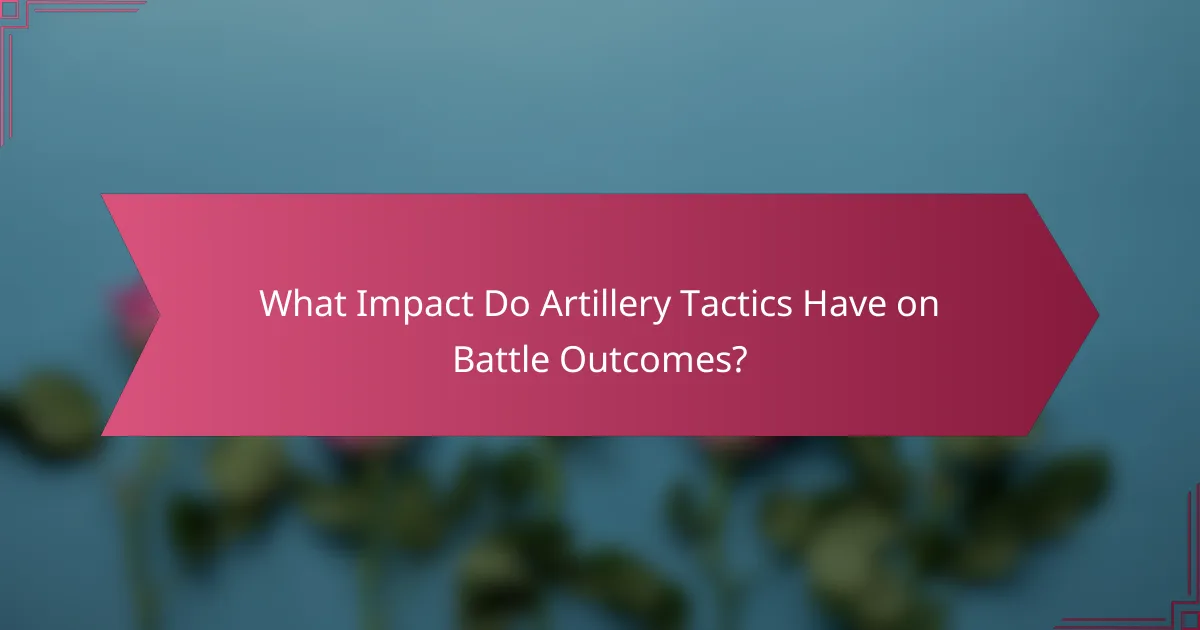
What Impact Do Artillery Tactics Have on Battle Outcomes?
Artillery tactics significantly influence battle outcomes by shaping the battlefield, affecting troop morale, and altering enemy movements. Effective use of artillery can create advantageous conditions for ground forces, disrupt enemy plans, and demoralize opposing troops.
Shaping the battlefield
Artillery tactics shape the battlefield by creating physical obstacles and altering terrain features. For instance, bombardments can destroy fortifications or create craters that hinder troop movements. This manipulation of the environment can force the enemy to adapt their strategies, often to their detriment.
Additionally, artillery can establish zones of control, making certain areas too dangerous for enemy forces. This control can dictate the flow of battle, as commanders can funnel enemy troops into kill zones or away from strategic objectives.
Psychological effects on troops
The psychological impact of artillery on troops is profound. The sound of incoming shells and the destruction they cause can instill fear and anxiety among enemy soldiers, leading to decreased morale and effectiveness. Conversely, friendly artillery support can boost the confidence of allied troops, encouraging aggressive tactics.
Moreover, the unpredictability of artillery fire can create a constant state of stress for opposing forces, affecting their decision-making and overall performance. This psychological warfare can be as decisive as physical destruction on the battlefield.
Influencing enemy movements
Artillery tactics can effectively influence enemy movements by threatening key routes and positions. By targeting supply lines or retreat paths, artillery can force the enemy to reconsider their maneuvers, often leading to delays or miscalculations. This disruption can create openings for ground forces to exploit.
Furthermore, coordinated artillery barrages can compel the enemy to reposition their units, potentially exposing them to counterattacks. Understanding the enemy’s likely responses to artillery fire allows commanders to plan more effective operations and capitalize on their vulnerabilities.
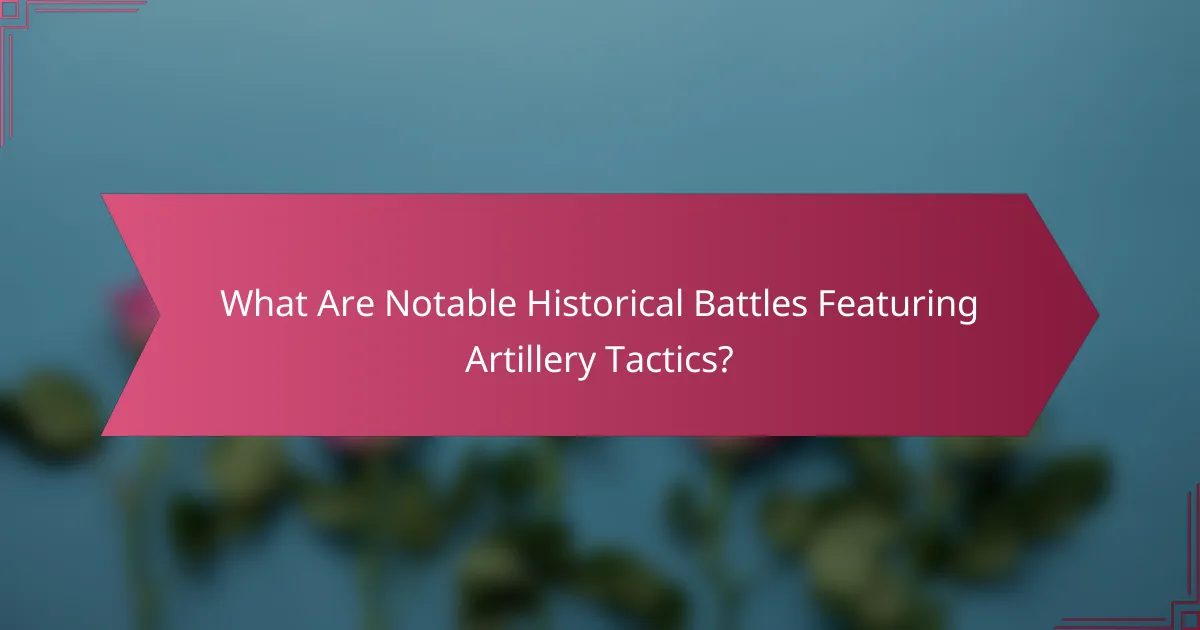
What Are Notable Historical Battles Featuring Artillery Tactics?
Several key battles throughout history prominently featured artillery tactics, significantly influencing their outcomes. These battles demonstrate the strategic importance of artillery in warfare, showcasing its power to shape the battlefield and affect troop movements.
The Battle of Gettysburg
The Battle of Gettysburg, fought in July 1863 during the American Civil War, is renowned for its extensive use of artillery. Union and Confederate forces deployed thousands of cannons, with the Union’s artillery playing a crucial role in repelling Pickett’s Charge, a pivotal moment in the battle.
Artillery tactics at Gettysburg included the use of high ground to maximize range and effectiveness. The Union’s position on Cemetery Hill allowed them to deliver devastating fire on advancing Confederate troops, demonstrating the importance of terrain in artillery deployment.
The Siege of Vicksburg
The Siege of Vicksburg, occurring from May to July 1863, showcased artillery’s role in siege warfare. Union forces, under General Ulysses S. Grant, utilized heavy artillery to bombard the Confederate defenses, ultimately leading to the city’s surrender.
Effective artillery tactics included the establishment of siege lines and the use of rifled cannons, which increased accuracy and range. This prolonged bombardment weakened Confederate morale and resources, illustrating how sustained artillery fire can break enemy resistance.
The Battle of Stalingrad
The Battle of Stalingrad, fought from 1942 to 1943 during World War II, highlighted the devastating impact of artillery in urban warfare. Both the Axis and Soviet forces relied heavily on artillery to support infantry assaults and defend positions in the city’s ruins.
Artillery tactics in Stalingrad involved the use of heavy bombardments to soften enemy defenses before ground attacks. The Soviets employed counter-battery fire to neutralize German artillery, emphasizing the importance of targeting enemy firepower in urban combat scenarios.
The Gulf War
The Gulf War in 1990-1991 demonstrated modern artillery tactics, including precision-guided munitions and advanced targeting systems. Coalition forces effectively used artillery to destroy Iraqi command and control centers, significantly disrupting enemy operations.
Key tactics included the integration of artillery with air support, allowing for rapid strikes on high-value targets. The use of GPS-guided artillery shells improved accuracy, reducing collateral damage and enhancing operational effectiveness in the conflict.
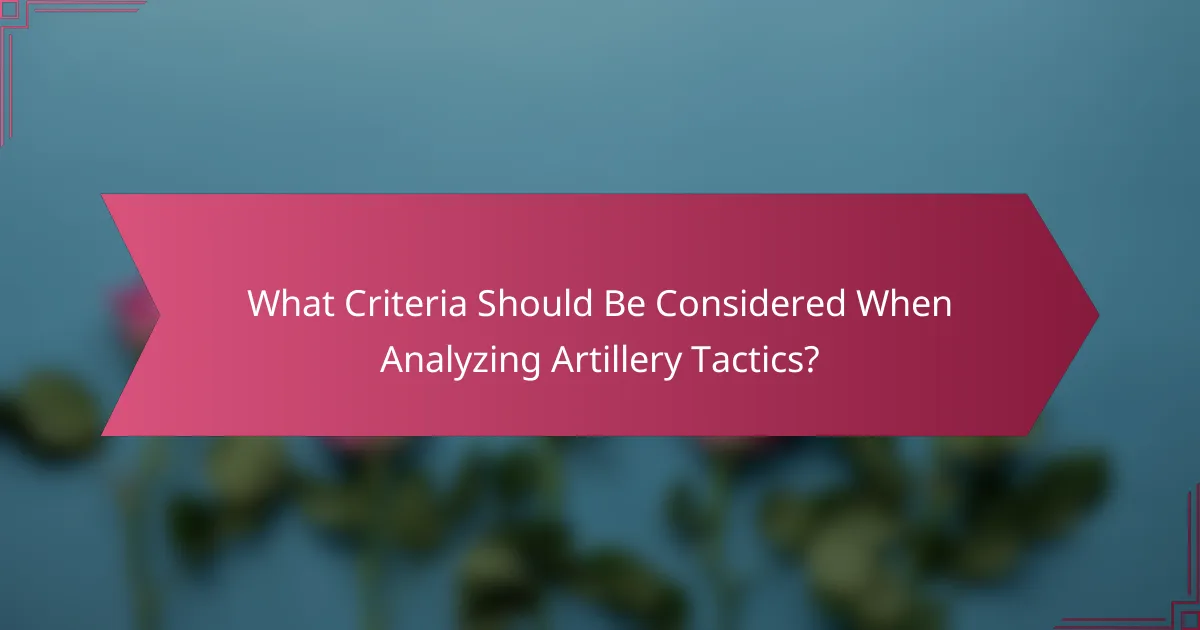
What Criteria Should Be Considered When Analyzing Artillery Tactics?
When analyzing artillery tactics, key criteria include the type of artillery used, the terrain, the objectives of the operation, and the enemy’s capabilities. Understanding these factors helps in assessing effectiveness and adapting strategies for different combat scenarios.
Type of Artillery
The type of artillery significantly influences tactical decisions. Different artillery pieces, such as howitzers, mortars, and rocket artillery, have unique ranges, rates of fire, and payloads. For instance, howitzers are effective for long-range bombardment, while mortars excel in indirect fire support in close combat situations.
When selecting artillery, consider the mission requirements. Heavy artillery may be necessary for breaching fortified positions, while lighter, mobile units can provide rapid support in fluid battlefields. Understanding the strengths and weaknesses of each type allows for better tactical planning.
Terrain Considerations
Terrain plays a crucial role in artillery effectiveness. High ground can enhance range and accuracy, while dense urban environments may limit visibility and maneuverability. Analyzing the battlefield topography helps in positioning artillery for optimal impact and protection.
For example, in mountainous regions, artillery may need to be positioned at higher elevations to maximize its range. Conversely, in flat terrains, dispersed placement can mitigate the risk of counter-battery fire. Adapting tactics to the terrain ensures artillery can deliver maximum firepower while minimizing vulnerabilities.
Objectives of the Operation
Clearly defined objectives guide artillery tactics. Whether the goal is to destroy enemy positions, support infantry advances, or provide suppressive fire, the artillery strategy must align with these aims. Artillery can be used for both offensive and defensive operations, depending on the mission.
For instance, if the objective is to support an infantry assault, coordinating artillery barrages to precede troop movements can enhance effectiveness. Conversely, if the aim is to hold a defensive line, artillery may focus on interdicting enemy advances. Aligning tactics with operational goals is essential for success.
Enemy Capabilities
Understanding the enemy’s capabilities is vital when analyzing artillery tactics. Knowledge of the enemy’s artillery, air defense systems, and mobility can inform strategic decisions. For example, if the enemy possesses advanced counter-battery radar, artillery units may need to employ more mobile tactics to avoid detection.
Additionally, assessing the enemy’s potential responses can help in planning artillery strikes. If the enemy has strong air defenses, using artillery in conjunction with air support may be necessary to suppress those threats. Adapting tactics based on enemy capabilities enhances the likelihood of mission success.
